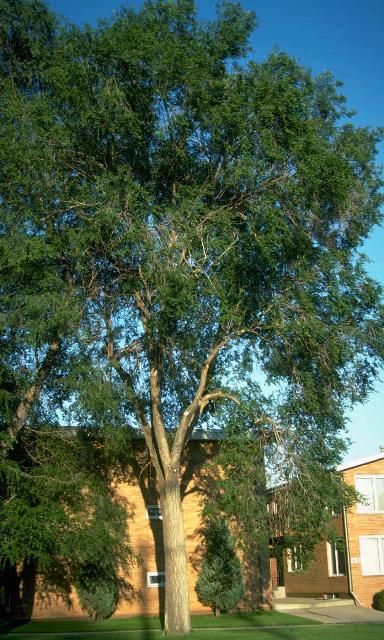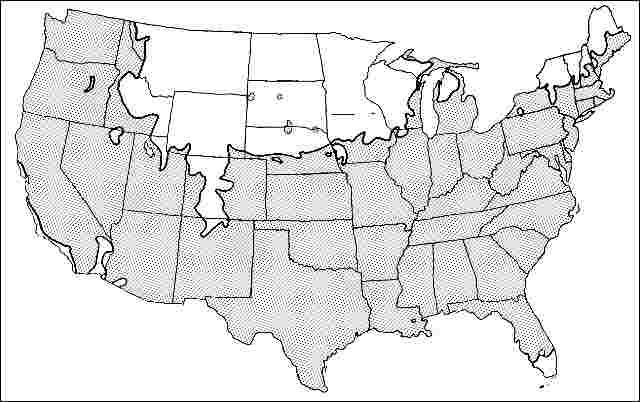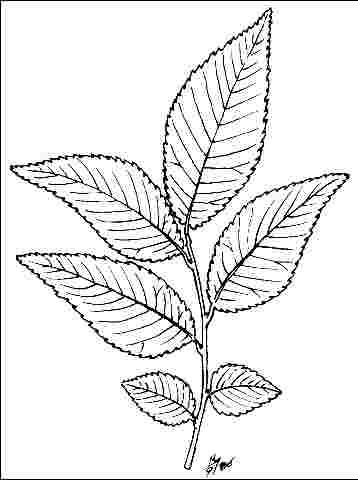Ulmus pumila: Siberian Elm1
Introduction
This rapidly-growing deciduous tree has a rounded canopy with somewhat drooping branches, and reaches 40 to 60 feet in height with a spread of 35 to 50 feet. The glossy green, two to three-inch-long by 0.5- to 1-inch-wide leaves turn pale yellow in fall before dropping. The inconspicuous, green, springtime flowers are produced in small clusters among the leaves and are followed by half-inch-long, flat, winged seedpods which mature during early summer. The wood is fairly brittle and subject to damage during storms, which creates a lot of twig litter on the lawn afterward. Since major limbs split from the crotches on older trees, this is considered a tree to avoid. Most urban tree managers and horticulturists will not recommend planting this tree. However, recent observations showed that improper pruning, including topping, may be partially responsible for the tree's weak-wooded reputation.

Credit: Ed Gilman, UF/IFAS
General Information
Scientific name: Ulmus pumila
Pronunciation: UL-mus PEW-mih-luh
Common name(s): Siberian elm
Family: Ulmaceae
USDA hardiness zones: 5A through 9B (Fig. 2)
Origin: not native to North America
Invasive potential: little invasive potential
Uses: shade
Availability: somewhat available, may have to go out of the region to find the tree

Description
Height: 50 to 70 feet
Spread: 35 to 50 feet
Crown uniformity: irregular
Crown shape: vase
Crown density: moderate
Growth rate: fast
Texture: medium
Foliage
Leaf arrangement: alternate (Fig. 3)
Leaf type: simple
Leaf margin: serrate
Leaf shape: elliptic (oval), lanceolate
Leaf venation: pinnate
Leaf type and persistence: deciduous
Leaf blade length: less than 2 inches
Leaf color: green
Fall color: yellow
Fall characteristic: showy

Flower
Flower color: green
Flower characteristics: not showy
Fruit
Fruit shape: round
Fruit length: .5 to 1 inch
Fruit covering: dry or hard
Fruit color: brown
Fruit characteristics: does not attract wildlife; not showy; fruit/leaves a litter problem
Trunk and Branches
Trunk/bark/branches: branches droop; not showy; typically one trunk; thorns
Pruning requirement: needed for strong structure
Breakage: susceptible to breakage
Current year twig color: gray, green
Current year twig thickness: thin
Wood specific gravity: unknown
Culture
Light requirement: full sun
Soil tolerances: clay; sand; loam; alkaline; acidic; extended flooding; well-drained
Drought tolerance: high
Aerosol salt tolerance: moderate
Other
Roots: can form large surface roots
Winter interest: no
Outstanding tree: no
Ozone sensitivity: tolerant
Verticillium wilt susceptibility: susceptible
Pest resistance: sensitive to pests/diseases
Use and Management
Siberian elm grows well in full sun on well-drained soil. This tree is easily grown and will tolerate a variety of adverse conditions, such as poor soil, drought, and moderate salt. It is probably best saved for the reclamation site or other out-of-the-way location. It is also useful in climates where many other trees grow poorly. This could include the drier parts of the central United States.
Propagation is by seed or layering.
Pests
Mites and elm leaf beetles infest this elm. The tree is considered weak wooded.
Diseases
Wetwood disease can infect the trunk.


